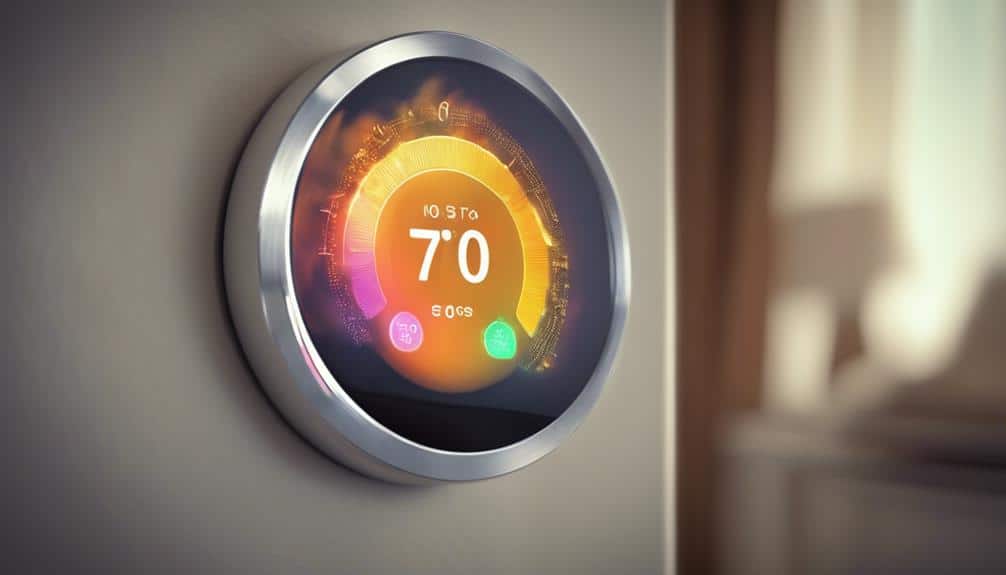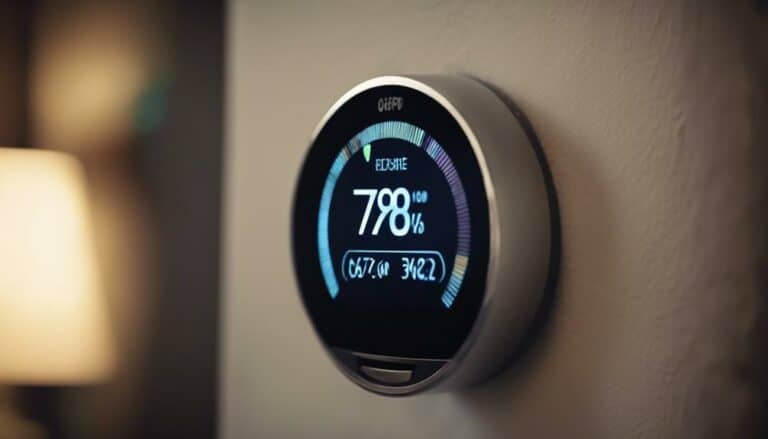Did you know that leveraging data from smart thermostats can lead to energy savings of up to 23%?
Imagine having the ability to optimize your energy usage and reduce costs simply by utilizing the data collected by your smart thermostat.
By harnessing insights on temperature, occupancy patterns, and weather conditions, you hold the key to a more sustainable and efficient approach to managing energy consumption.
But how exactly can this data be harnessed to achieve such remarkable savings and contribute to a greener environment?
Key Takeaways
- Smart thermostat data optimizes energy efficiency through behavior-driven temperature adjustments.
- Predictive alerts enable early identification of HVAC issues, enhancing system performance and longevity.
- Real-time monitoring and remote control features lead to up to 15% energy savings.
- Utilizing smart thermostat analytics results in significant cost reductions and sustainable energy consumption.
Energy Insights and Consumption Analysis
By analyzing data on temperature, occupancy, humidity, and weather conditions, smart thermostats optimize energy usage for efficient consumption management. Smart thermostat analytics help in understanding energy usage patterns, enabling users to reduce energy consumption effectively. These thermostats provide valuable data insights that empower individuals to adjust temperature settings based on detailed information. With the assistance of smart devices, users can make informed decisions regarding their energy efficiency and reduce wastage.
Through the data collected by smart thermostats, users can gain a thorough understanding of their energy consumption habits. By leveraging this information, individuals can tailor their energy usage to be more environmentally friendly and cost-effective. Smart thermostat data analysis not only helps in reducing energy consumption but also provides recommendations on how to conserve energy effectively. By utilizing the insights obtained from smart thermostats, users can make impactful changes to their energy consumption behaviors, leading to significant energy savings.
Smart Thermostat Data Utilization
When you harness smart thermostat data, you gain insights into your energy usage patterns.
This knowledge empowers you to make behavior-driven temperature adjustments, optimizing your energy consumption.
Energy Usage Patterns
Smart thermostat data utilization reveals insightful energy usage patterns that empower you to enhance efficiency and reduce waste. By analyzing data from smart thermostats, you can understand your energy consumption better, make informed decisions, and improve efficiency in heating and cooling cycles.
The occupancy patterns detected by smart thermostats help optimize temperature settings automatically, further aiding in energy savings. Additionally, the data analysis may highlight energy-hungry appliances that could benefit from optimization or upgrades, giving you the knowledge needed to make impactful changes for conservation efforts.
Take control of your energy usage patterns with the valuable insights provided by smart thermostats.
Behavior-Driven Temperature Adjustments
Utilizing behavior-driven temperature adjustments through smart thermostat data allows for personalized comfort settings and significant energy savings. Smart thermostats analyze occupancy patterns and user behavior insights to optimize heating and cooling efficiency. By leveraging this data, these devices can automatically adjust temperatures based on individual preferences, leading to tailored schedules that enhance comfort while conserving energy. This approach not only guarantees a cozy environment but also contributes to substantial energy conservation efforts. Below is a table summarizing the key benefits of behavior-driven temperature adjustments using smart thermostat data:
| Benefits | Description |
|---|---|
| Personalized Settings | Tailored temperature control for individual needs |
| Energy Savings | Significant reduction in energy consumption |
| Efficient Heating & Cooling | Optimized temperature adjustments for efficiency |
| Occupant Behavior Insights | Insights used to create customized schedules |
Optimizing Energy Efficiency With Analytics

To optimize energy efficiency with analytics, you can monitor energy usage patterns, receive predictive maintenance alerts, and make remote temperature adjustments.
By analyzing these data points, you can fine-tune your energy consumption in real-time, leading to significant cost savings and improved sustainability.
Implementing these analytics-driven strategies can enhance your building's overall energy efficiency and performance.
Energy Usage Patterns
By tracking and analyzing energy usage patterns, smart thermostats optimize efficiency and reduce waste, leading to significant energy conservation. This data-driven approach allows for informed decisions on energy consumption, maximizing efficiency through the analysis of occupancy patterns.
Integration of weather data further enhances this optimization, adjusting energy usage based on external conditions. By preventing unnecessary heating or cooling of unoccupied rooms, smart thermostats actively contribute to energy conservation efforts.
- Make informed decisions on energy consumption.
- Maximize efficiency through occupancy pattern analysis.
- Enhance optimization with integration of weather data.
- Actively contribute to energy conservation by preventing unnecessary heating or cooling.
Predictive Maintenance Alerts
Enhance your energy efficiency with smart thermostats through predictive maintenance alerts that identify potential issues before they escalate, optimizing system performance and reducing operational costs. By leveraging data analytics, you can implement proactive maintenance strategies that address potential HVAC system malfunctions early on, leading to increased system efficiency and longevity. This proactive approach not only minimizes energy waste but also lowers operational costs associated with major repairs. Smart thermostats provide real-time insights, enabling you to prevent energy waste and guarantee peak system performance. Embracing predictive maintenance alerts fosters sustainable practices in building management, aligning with your goals for energy conservation and efficiency.
| Benefits of Predictive Maintenance Alerts | |
|---|---|
| Early detection of potential issues | Optimized system performance |
| Reduced operational costs | Proactive maintenance strategies |
Remote Temperature Adjustments
Shifting from predictive maintenance alerts, leverage the capabilities of smart thermostats for remote temperature adjustments to optimize energy efficiency through real-time data analytics. By adjusting temperature settings based on occupancy patterns and weather conditions remotely, you can effectively reduce energy consumption and lower utility bills.
With remote control features, you have the power to optimize heating and cooling in your home even when you're away. Take advantage of smart home devices to prevent energy waste and achieve up to 15% in energy savings.
Embrace the convenience of real-time data analytics for precise temperature control, ensuring your home is always comfortable and energy-efficient.
Leveraging Data for Conservation Strategies

Leveraging data from smart thermostats enables you to implement effective conservation strategies, leading to significant cost savings and environmental benefits. Smart thermostat analytics provide valuable insights to optimize energy consumption, reduce energy waste, and lower greenhouse gas emissions.
By utilizing predictive maintenance through data monitoring, you can enhance system efficiency, contributing to extended equipment lifespan and decreased energy wastage. Homes equipped with smart thermostats typically save 8% on heating and cooling costs annually, while those with advanced data-driven strategies can see even greater savings of 10-12% on heating and 16% on cooling expenses.
Through smart thermostat data, you can proactively adjust settings and adopt energy conservation strategies that result in substantial reductions in energy consumption, ultimately benefiting both your wallet and the planet.
Data-Driven Energy Savings Techniques
By analyzing data collected from smart thermostats, you can implement effective techniques to save energy and reduce costs in your home. Leveraging smart thermostat analytics allows for data-driven energy optimization, leading to a more efficient use of energy.
This not only helps in reducing energy consumption but also aids in decreasing greenhouse gas emissions, contributing to a greener environment. Predictive maintenance, based on continuous data monitoring from smart thermostats, enhances system efficiency and prolongs its lifespan, ensuring top performance.
Enhancing Conservation Through Data Analytics

To further enhance energy conservation through data analytics, you can harness the insights provided by smart thermostat data to optimize your household's energy usage effectively. By leveraging smart thermostat data, you can achieve significant savings on heating and cooling costs, with homeowners saving an average of 8% annually.
Additionally, predictive maintenance driven by data monitoring not only increases system efficiency but also contributes to extended equipment lifespan. Through the utilization of data for optimized energy consumption, greenhouse gas emissions can be reduced, further benefiting the environment.
Smart thermostat data plays an important role in reducing energy waste within households, leading to substantial cost savings. Households equipped with smart thermostats typically save around 10-12% on heating and 16% on cooling costs annually, showcasing the tangible impact of utilizing data analytics for energy conservation.
Embracing these insights can result in increased efficiency, reduced costs, and a more sustainable approach to managing your home's energy consumption.
Smart Thermostat Analytics for Efficiency
Smart thermostat analytics provide real-time tracking of HVAC system usage and energy consumption, enabling informed decisions to optimize temperature settings and enhance energy savings. By leveraging smart thermostat analytics, you can benefit from features such as occupancy detection and weather integration, which help adjust settings for maximum efficiency.
The detailed reports generated by smart thermostats offer valuable insights into energy consumption patterns, allowing you to identify areas for optimization and make informed decisions regarding your HVAC system usage. With up to a 35% reduction in energy consumption reported in commercial buildings, the energy efficiency benefits of smart thermostat analytics are undeniable.
Take advantage of the opportunity to enhance your energy conservation efforts through the power of real-time monitoring and optimization provided by smart thermostat analytics.
Frequently Asked Questions
How Do Smart Thermostats Conserve Energy?
Smart thermostats conserve energy by adjusting temperatures based on occupancy and integrating weather data. They save up to 23% on costs annually, prevent unnecessary heating or cooling, reduce emissions, and offer personalized recommendations for energy efficiency.
What Are the Environmental Benefits of Smart Thermostats?
Smart thermostats offer environmental benefits like reduced carbon emissions and energy conservation. They lead to significant cost savings and lower greenhouse gas emissions. By adopting them widely, you can contribute to a cleaner planet.
What Data Do Smart Thermostats Collect?
Smart thermostats collect data on temperature, occupancy, humidity, and weather conditions. This information helps you understand energy usage patterns and optimize efficiency. With insights from the data, you can make informed decisions for energy conservation.
How Much Energy Can You Save by Lowering Your Thermostat?
You can save up to 10% on heating and cooling costs each year by lowering your thermostat by 7-10°F for 8 hours daily. Smart thermostats, saving an average of 8%, help households cut energy bills efficiently.
Conclusion
You can make a big impact on energy conservation by harnessing the power of smart thermostat data.
With real-time insights and personalized analysis, you can optimize energy usage, reduce costs, and contribute to a more sustainable future.
By leveraging data-driven strategies and techniques, you have the potential to achieve significant energy savings and make a difference in reducing carbon emissions.
Take control of your energy consumption and start making a positive impact today with smart thermostat analytics.

